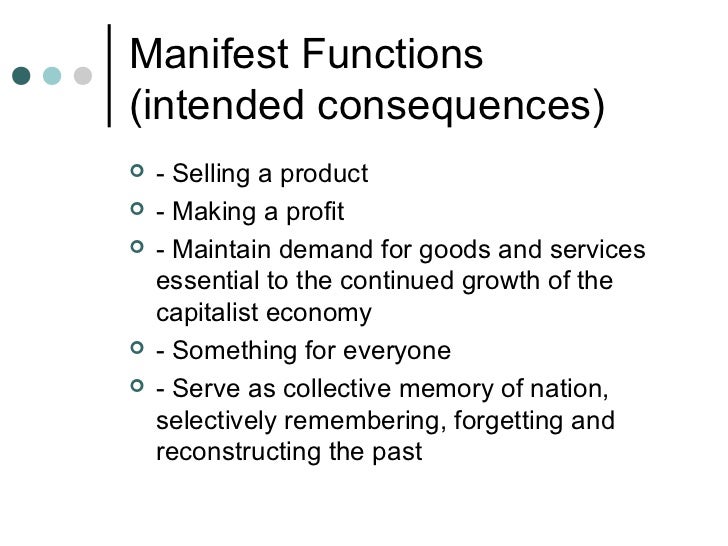Have you ever noticed how something meant to solve a problem can actually create new ones? Or how a simple act can ripple through society and have unforeseen consequences? This is the essence of manifest functions, a concept in sociology that explores the intended and unintended outcomes of social structures.

Image: keplarllp.com
Understanding manifest functions is crucial for comprehending the complex dynamics of society. It helps us see beyond the obvious and appreciate how seemingly simple actions can have far-reaching consequences. This article delves into the definition, history, and applications of manifest functions, unraveling the hidden layers within our social world.
Defining Manifest Functions: Unveiling the Intended Purposes
In essence, manifest functions refer to the intended consequences of social structures, actions, or institutions. Think of them as the primary goals or objectives that individuals and societies consciously strive for. These functions are often explicitly stated, easily recognized, and readily accepted by the majority.
For example, let’s consider the education system. Its manifest function is to impart knowledge and skills to students, prepare them for future careers, and contribute to the overall development of society. This function is openly acknowledged and pursued by both educators and policymakers.
History of Manifest Functions: A Sociological Milestone
The concept of manifest functions was popularized by renowned sociologist Robert K. Merton in his seminal work “Social Theory and Social Structure.” Merton, a prominent figure in the functionalist school of thought, emphasized the importance of understanding both the explicit and implicit consequences of social phenomena.
Prior to Merton’s work, sociologists primarily focused on the visible, intended functions of social structures. Merton, however, recognized that social interactions are complex and often produce unintended consequences. This insight led to the development of the concept of latent functions, which we will explore later.
Beyond the Facade: Unmasking Latent Functions
While manifest functions are clearly stated and often deliberate, latent functions are the hidden or unintended consequences of social structures. They represent the unforeseen outcomes that emerge from seemingly simple actions. Latent functions can be beneficial, neutral, or even harmful, and they often highlight the complex interplay of social forces.
Continuing our education system example, a latent function might be the development of social networks and friendships among students. This outcome is not the primary purpose of education but emerges naturally within the school environment.
:max_bytes(150000):strip_icc()/GettyImages-493189993-5811b8f95f9b58564c341106.jpg)
Image: www.thoughtco.com
Examples of Latent Functions: Uncovering Hidden Impacts
Here are some real-world examples of latent functions:
- Sports: The manifest function of sports is to provide physical activity and entertainment. However, a latent function can be the development of teamwork, leadership skills, and a sense of community among players.
- Social Media: The manifest function of social media platforms is to connect people and share information. However, a latent function can be the spread of misinformation, cyberbullying, and social isolation.
- Tourism: The manifest function of tourism is to promote economic growth and cultural exchange. However, a latent function can be the environmental damage and cultural appropriation that can occur in tourist destinations.
The Importance of Examining Manifest and Latent Functions
Understanding both manifest and latent functions is crucial for several reasons:
- Policymaking: By comprehending the unintended consequences of policies, policymakers can anticipate and mitigate potential negative outcomes.
- Social Change: Identifying latent functions can shed light on the forces driving social change and uncover unexpected consequences of social movements.
- Problem-Solving: Recognizing latent functions can help us develop more effective solutions to social problems by addressing both the intended and unintended consequences.
Critical Analysis: Questioning the Assumptions
While the concepts of manifest and latent functions offer valuable insights into social dynamics, they are not without their limitations. Critics argue that:
- Oversimplification: The functionalist perspective can oversimplify complex social phenomena and ignore the agency of individuals in shaping society.
- Power Dynamics: The concept of manifest functions can be used to legitimize societal structures that benefit certain groups over others, ignoring power dynamics and inequality.
- Lack of Empirical Evidence: Critics argue that the identification of latent functions can be subjective and lack robust empirical evidence.
Moving Forward: Embracing a Multifaceted Approach
Despite these criticisms, the concepts of manifest and latent functions remain valuable tools for understanding social phenomena. By acknowledging both the intended and unintended consequences of social structures, we can develop a more nuanced understanding of society and work towards more equitable and sustainable outcomes.
Manifest Functions Definition
Call to Action: Engage with the World Around You
As you navigate the world, be mindful of the manifest and latent functions of the institutions and social structures you encounter. Reflect on the intended and unintended consequences of actions, both individual and collective. By embracing a critical lens, we can contribute to a more just and informed society.





